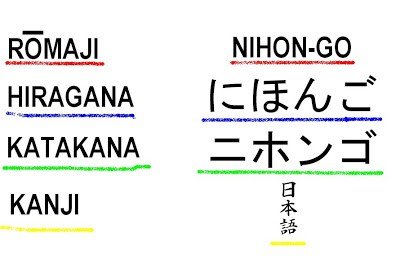Have you ever wondered why the Japanese incorporated Kanji, or Chinese ideograms, into their language? In this article, we'll explore the importance of Kanji and why they are indispensable in Japanese writing.
The Japanese language is a complex system that uses three types of writing: Hiragana and Katakana, syllabaries with 46 characters each (plus two obsolete ones), which together form around 104 syllables. In addition, there are the famous Chinese ideograms, the Kanji, which number over 8,000. In practice, a Japanese person needs to learn approximately 1945 Kanji to communicate effectively, and each of these ideograms can have several pronunciations, totaling 4087 different readings.
With Hiragana, you can write any Japanese word, as it covers all 104 syllables of the language. So why do the Japanese insist on using Kanji? Couldn't they simply use Roman characters or just Hiragana? The answer is a resounding NO!

Table of Content
Different ways of writing the Japanese language
There is a logical explanation for the use of Chinese ideograms in the Japanese language, and it is related to one of the greatest difficulties in learning the language: the numerous homophone words.
Homophones are words that have the same pronunciation but different meanings. In Japanese, if you only use Hiragana, many words will have the same pronunciation and spelling, making them homonymous and difficult to understand.
God x Paper x Hair
Imagine Kanji didn't exist. How would you translate the phrase "かみです" (kami desu)? It would be practically impossible, because you wouldn't know the real meaning of "Kami". Now look at the same sentence with the Kanji:
- (かみです) 神です = God
- (かみです) 紙です = Paper
- (かみです) 髪です = Hair
"です" can be understood as "is" or "being", depending on the context.
The Japanese use the context of the conversation and the situation a lot to communicate. During a conversation, you would probably understand the meaning, but when reading a text or sentence in isolation, you could be completely lost.
Japanese is full of the same words. In addition, there are words that are just one syllable, such as "hand" (手, て, te) and "eye" (目, め, me). Without the ideograms, it would be impossible to identify these words in a text.
And the problem doesn't stop there. There are words that can have more than 50 words with the same pronunciation. Not to mention words that look like particles or other words. How could you read a text like that?
We recommend reading: What is the meaning of Kami?
Hiragana x Kanji
If you're still not satisfied with the above examples, let's look at some other examples to help you understand why Japanese needs to use ideograms:
- Hiragana みぎみみみぎめみぎめみぎみみ
- Kanji 右耳右目右目右耳;
- Romaji Migimimimigimemigimemigimimi
Can you understand this sentence just with hiragana? This is quite a tongue twister, which means "Right ear, right eye, right eye, right ear"
- Hiragana すもももももももものうち
- Kanji すももも桃ももものうち
- Romaji Sumomo mo momo mo momo no uchi
I can understand what is written only with hiragana? I only see a lot of momomomo... The sentence means "Plums and peaches belong to the peach family".
Let's take an easier and more common example: "ははは..." You'll probably hear this phrase a lot, but do you know what it means? With kanji it would be 母は... that is "The mother..." Reading only ははは you can get lost and think of another word or a laugh.
It's much easier to understand the sentences above with Kanji. Not only is the text smaller, but it's even quicker to read and write. Knowing the Kanji, you can really understand the sentence as soon as you read it.
English, Korean and Chinese
What about homophones in Portuguese? In Portuguese, there are the same words written in different ways, as well as countless accents. It would be practically impossible to do this with Japanese, as it only has 104 syllables.
The Koreans created their own alphabet, Hangul, which has 14 consonants and 10 vowels, but which, when combined, make up to 1960 different sounds, eliminating the problem of homophones. Unfortunately, to do away with the Kanji, it would be necessary to completely change the Japanese language, which is quite difficult.

The Chinese use ideograms in a simplified way. Why don't the Japanese do the same? Well, there's no definitive answer to that question. Japan is an ancient country that adopted its writing before simplified Chinese existed. This would probably involve the way Japanese is taught, the radicals and the words that are already ingrained in the minds of the Japanese people. However, the Japanese make the necessary changes to some ideograms, so there's no reason to question it.
The Japanese language has undergone numerous changes since its origin, which has led Japan to have numerous dialects. Changing the writing system and pronunciation would cause numerous problems and difficulties. The kanji is something common in Japanese; it's not a monster with seven heads. Japanese people really do not see reasons to make changes or adopt a way to simplify the ideograms.
What about you? What do you think of Japanese ideograms? Is it a big challenge? Share it with your friends and let us know what you think on our YouTube community and social networks.
